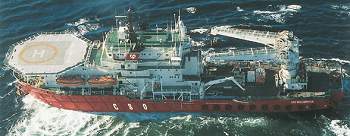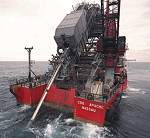 contracts in Norway My next call was Tim Sheehan, Business Development Manager at Coflexip Stena Offshore Ltd (CSOL) at the UK headquarters in Westhill. I gathered this overview of the company's formidable subsea capabilities. CSOL is also a turnkey EPIC contractor and operates at the same level as Stolt Offshore. Its claim to be the most highly integrated subsea solutions provider in the global oil and gas industry must be taken seriously. Its formidable fleet includes four pipelay vessels, CSO Deep Blue (under construction), Sunrise 2000, CSO Apache and Flexservice I, and ten subsea construction vessels - the CSO Alliance, CSO Constructor, CSO Marianos, CSO Orelia, CSO Seawell, CSO Venturer, CSO Wellservicer, Seamec 1, Seamec 2 and Seamec 3 - plus a trenching vessel, Normand Pioneer. The company's worldwide work force numbers some 3900, spread over five continents. Figures from 1999 indicate that most of CSOL's revenue (which gave a net total of EUR 1017 million) was derived from contracting (68%), followed by supply, which accounted for 15%. Diving and IRM provided 8%, and the remaining 9% was shared between robotics (4%), umbilicals (2%), drilling, refining and land applications (2%), and 1% other. Geographically, the North Sea has continued to be the biggest earner, accounting for 50% of the revenues. Brazil was second with 13%. Asia Pacific provided 11% and the rest of the world, including France, brought in 26%. CSOL has its sights firmly fixed on the deep and ultra deep-water fields of the "golden triangle". With this in mind, it has been concentrating on research and development since 1997. In particular it has been developing a range of new technologies - including the next generation of rigid and flexible pipes, reeled steel catenary riser and hybrid catenary riser architectures, pipe-in-pipe, an automatic welding system which can work on pipe up to 30in diameter, and a modular J-lay system.
Big hopes are focused on the company's new ultra-deep pipelaying vessel, the CSO Deep Blue, for both rigid and flexible lines, which has just been launched in Korea and will be commissioned early in 2001 after installation of her pipelay equipment in the Netherlands. This flagship project represents an investment of an impressive EUR 180 million. The target depth currently stands at 2500msw. Supported by the just-established Deep Water Field Development Division, CSOL interfaces actively with clients and produces conceptual and front-end engineering solutions at the earliest stage of projects. Despite an unfavourable business environment in 1999, CSOL helped bring 11 new fields onstream in the North Sea, and vessel utilisation was at an all-time high of 85%. Among these was the Enterprise Oil Cook field EPIC contract, which exploited CSOL's patented Teta flexible and pipe-in-pipe technologies. The Elf Elgin Franklin project provided CSOL with its world first in using its automatic hyperbaric welding system. CSOL has been awarded the contract for the UK's first deep-water abandonment for the removal of the Phillips Maureen platform. Other work sites included the Talisman Ross field, Texaco's Captain B and Marathon's Kinsale. On the Norwegian side, CSOL installed risers on SAGA Snorre, Statoil Asgard B, Norsk Hydro Visund, Esso Balder and Statoil Loke. As we go to press, CSOL has announced over EUR 60 million EPIC contracts in Norway. These are the Garn West pipeline and installation in 270msw for A/S Norske Shell, and the Ringhorne subsea and platform tieback contract in 130msw for Esso Exploration and Production Norway AS. Both start in summer 2001. Offshore Brazil, CSOL helped Petrobras achieve a new world record depth for flexible pipe in Y2000 (1883msw) on Roncador. CSOL's deep pipelay vessel, Sunrise 2000, which is on long-term charter to Petrobras, has been upgraded and is now capable of laying three lines simultaneously in water depths down to 2000msw. In the Asia Pacific region, CSOL completed a 3-year deep-water EPIC project on Woodside Laminaria-Corallina in alliance with JP Kenny (CSK) using CSO Venturer in Australia. This was a remote and deep (400msw) FPSO development. On Woodside Lambert/Wanaea-Cossack CSOL installed the subsea manifold and flexible, as well as completing the field maintenance with CSO Marianos. Also offshore Australia, CSO Apache laid the deepest (400msw) offshore pipe-in-pipe and rigid reeled pipeline, on Esso Blackback. Meanwhile, in India, CSOL supplied 29.6km of flexible water injection replacement pipeline on Larsen & Toubro CRMP II. In the Gulf of Mexico, CSOL has been awarded the design, construction and installation in 2001 of the first ultra-deepwater (1100m) reeled steel catenary riser and pipe-in-pipe steel flowline. Across the Atlantic, on Cabgoc Fuito, offshore Angola, in the short time of 15 months from letter of intent to first oil, CSOL developed the field in alliance with SBM and ABB. This was a textbook example of CSOL technology, coordination and speed of implementation. CSOL's newly-built trenching vessel Normand Pioneer (on long-term charter from Solstad) was recently called out in emergency by the Royal Navy to take their submarine rescue submersible LR 5 to the site of the lost Russian nuclear submarine Kursk. Sadly, it was found that there was no need for the LR 5's services because the Kursk was completely flooded. CSOL's story would not be complete without referring to its winning the top honour for Safety Excellence at this year's Scottish Offshore Achievement Awards (featured in our previous issue). Underwater Contractor International adds its congratulations to CSOL for this well-deserved accolade. The Coflexip Stena Offshore websites are at www.coflexipstenaoffshore.com |
© 2000 Underwater World Publications Ltd.

